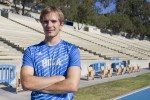Dictated by high school success and status as a walk-on, senior jumper Michael Perry’s collegiate career was surging.
However, what had happened to Perry was an athlete’s worst nightmare.
Without warning, he received a phone call from his coach, Anthony Curran.
Perry was cut from the team.
“I was devastated because I didn’t expect it all. I thought they would tell me I had to jump a certain distance before they cut me. It was pretty sudden and unexpected,” Perry said.
A tendon injury had prevented Perry from making much of an impact his sophomore year, but the surprise came in that he expected a chance to make up for the poor second season – especially after a successful first one.
During that freshman season, he had achieved a top triple jump mark of 45 feet 3 inches, assisted the Bruins in defeating the USC Trojans by earning fourth in the long jump and received Athletic Director’s Honor Roll.
Perry’s freshman-year success stemmed from a celebrated high school career at La Salle High School. There he won three MVP awards, claimed two league championships in the triple jump and won a league title in the long jump.
But in his sophomore season at UCLA, poor marks and an increasing roster forced the team’s hand and he was cut. He then faced an uphill battle to rejoin the team.
Perry was no stranger to dedication. After receiving accolades in high school, he contacted UCLA toward the end of his senior year in high school, and was told to reach a mark of 23 feet in order to make the team as a walk-on – his previous best to that point was 22.8 feet.
Perry hit the mark at a state meet and was on his way to join the UCLA track and field team as a walk-on.
Curran, Perry’s coach during his freshman year, praised Perry for his willingness to learn, mental prowess and ability to perform in the spotlight.
Nevertheless, the odds seemed stacked against Perry’s favor, as around 95 percent of all athletes who are let go don’t make it back on the team, according to Curran.
Perry didn’t care about the odds.
He was confident in his ability to make the team again, but rather than finding motivation in trying to prove his coaches wrong, he was motivated to prove to himself that he could be better, that his journey as a collegiate athlete was far from over.
“Looking back on it now, I was pretty upset that they cut me from the team, but actually, getting cut was the best thing that ever happened to me in regards to jumping. I had a lot of time figuring stuff out on my own,” Perry said.
During a nine-month period from the end of his sophomore year until the beginning of track season in his junior year, Perry recuperated and set his focus on rejoining the team.
His training with the team during his first two years included rigorous structured workouts inadequate for improving his jumping. The focus on weight lifting and a rigorous schedule stiffened his form and consistently jumping with good marks became difficult.
“For someone like me straight out of high school, it was very hard adjusting because I didn’t know about everything I should be doing such as rolling out or stretching,” Perry said. “So, for my freshmen and sophomore years, I was ridiculously tight – too tight to run with good form – and I was inefficient.”
Perry took a new approach to training by utilizing yoga and listening to his body more. The quality of the training became more important than the quantity.
Prior to using yoga, Perry’s muscle training forced overcompensation of muscle groups. However, with this new style of training, Perry learned to use his muscle groups in a more efficient manner. With improved efficiency in muscle use, flexibility increased resulting in better strides down the runway and better jumping.
Perry’s training was a solo initiative, but he certainly got his share of advice from professional jumpers training at UCLA – especially from professional triple jumper Milan Tiff.
Tiff, who trains at UCLA, was a strong influence and gave Perry advice on improving his jump.
“The main point I got from Tiff was that I need to use longer strides and gallop more on the runway so I can jump with more power,” Perry said. “Previously, I had always run like a sprinter and it’s very different.”
Tiff also advised him to use techniques such as the hitch kick as opposed to the hang method, which improved Perry’s speed and run off the board.
With training in tow, Perry performed at various all-comer meets trying to reach the 24-foot mark needed to get back on the team. He kept in constant contact with Curran in the hopes of returning.
“I didn’t expect Mike to come back because he was so good in school and music that I thought he’d be comfortable with that, but he called me every week to tell me how he did,” Curran said. “Little by little, he started hitting his marks and when it came time for the USC meet, we decided to put him back on.”
With that, Perry was back.
Perry’s return helped the team best USC’s men’s team in 2013 as he won the long jump event on his last jump, similar to this year’s dual meet.
Perry’s journey provides a good example of what individual determination can accomplish, according to multi-events coach Jack Hoyt. Despite all the limitations and odds stacked against his favor during his time off the team, Perry made the best of his situation and hasn’t looked back.
“He’s an inspiration to everyone on the team. He’s doing it everywhere, in the classroom, on the field, and the fact that he came back and helped us win in a USC dual meet last year is remarkable,” Curran said. “People can appreciate to be around someone like Perry.”
